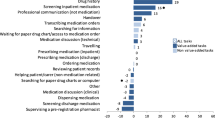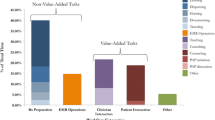Abstract
Despite the fact that since 1985 the government of Québec increased by 5.75 % on average the amount of money spent on healthcare per year, little improvement was noted. It is obvious that an optimal use of resources is essential to reduce waiting times and provide safer and faster services to patients. The use of new technology can contribute to improve the healthcare system efficiency. Our study aims to assess the impact of a medication distribution technology on 1) the performance of a health and social services center’s pharmacy, 2) the performance of one care unit in a nursing home and on 3) the medication-use process safety. To measure performance we were inspired by the Lean approach. The results show that medication distribution technology is considered as an effective way to significantly detect medication errors, to allow nurses to focus more on patients and pharmacy to react more rapidly to changes in patient medications.

Similar content being viewed by others
References
Canadian Institute for Health Information, (2009), Tendances des dépenses nationales de santé : 1975 à 2009. 193 pages.
Québec ministry of finance, (2010), Plan budgétaire 2010–2011, 408 pages
Liker, J., (2009), Le modèle Toyota: 14 principes qui feront la réussite de votre entreprise, Paris, Pearson Education, France, 392 pages
Breyfogle, F.W., (1999), Implementing Six Sigma: smarter solutions using statistical methods, John Wiley & Sons, 7e édition, 689 pages.
MSSS - Ministère de la santé et des services sociaux, (2005), Les systèmes automatisés et robotisés utilisés pour la distribution des médicaments dans les établissements de santé au Québec, Rapport et recommandations du groupe de travail, 116 pages.
Association des hôpitaux du Québec, (2004), La pratique pharmaceutique dans les établissements du Québec, analyse et recommandations, Comité de travail mixte de l’AHQ--directeurs des services professionnels et chefs de département de pharmacie, 33 pages.
Ministère de l’emploi et de la solidarité, (2001), L’informatisation du circuit du médicament dans les établissements de santé – Approche par l’analyse de la valeur : Quels projets pour quels objectifs?, Direction de l’hospitalisation et de l’organisation des soins, ministère délégué à la Santé, ministère de l’Emploi et de la Solidarité, Paris, France, 128 pages.
Huet, P., Paris, J.-L., Gourgand, M. et Kouiss, K., (2010), Modèle de connaissance générique du circuit du médicament dans un hôpital, Conférence international de modélisation et simulation - MOSIM’10, Hammamet, Tunisie, 8 pages.
Leape, L. L., Bates, D. W., Cullen, D. J., Cooper, J., Demonaco, H. J., Gallivan, T., Hallisey, R., Ives, J., Laird, N., and Laffel, G., Systems analysis of adverse drug events. J Am Med Assoc 274(1):35–43, 1995.
Novek, J., Clinical or industry pharmacy ? : Case studies of hospital pharmacy automation in Canada and France. Int J Health Serv 28(3):445–465, 1998.
Borel, J. M., and Rascati, K. L., Effect of an automated, nursing unit-based drug-dispensing device on medication errors. Am J Health Syst Pharm 52:1875–1879, 1995.
Shirley, K. L., Effect of an automated dispensing system on medication administration time. Am J Health Syst Pharm 56:1542–1545, 1999.
Guerrero, R., Nickman, N., and Jorgenson, J., Work activities before and after implementation of an automated dispensing system. Am J Health Syst Pharm 53:548–554, 1996.
Weaver, P.E. et Perini, V.J., (1998), Random sampling for quality assurance of the RxOBOT dispensing system, American Society of Health Systems Pharmacists Mid-Year Clinical Meeting, Las Vegas.
Klein, E. G., Santora, J. A., Pascale, P. M., and Kitrenos, J. G., Medication cart-filling time, accuracy, and cost with an automated dispensing system. Am J Hosp Pharm 51(9):1193–1196, 1994.
Cohen, E., Serour, S., and Zelovies, M., L’automatisation en l’an 2000. Pharmactuel 33(6):164–167, 2000.
Chapuis, C., Roustit, M., Gaelle, B., et al., Automated drug dispensing system reduces medication errors in an intensive care setting. Crit Care Med 38:1–7, 2010.
Van den Bemt, P. M. L. A., Idzingac, J. C., Robertz, H., Groot, K. D., and Pels, N., Medication Administration Errors in Nursing Homes Using an Automated Medication Dispensing Systems. J Am Med Inform Assoc 16(4):486–492, 2009.
Camac, K. J., Fisher, M. J., and Norris, D. E., Medication errors: a comparative study of drug storage sites. Aust J Hosp Pharm 26:34–37, 1996.
Fisher, M., Norris, D., Camac, K., and Hawkshaw, B., A comparison of medication errors between two storage sites. Contemp Nurse 11:55–59, 2001.
Alemanni, J., Touzin, K., Bussières, J. F., Descoteaux, R., and Lemay, M., An assessment of drug administration compliance in a university hospital center. J Eval Clin Pract 16(5):920–926, 2010.
Bennett, J., Harper-Femson, L. A., Tone, J., and Rajmohamed, Y., Improving medication administration systems: an evaluation study. Can Nurse 102:35–39, 2006.
Sobek Durward k.J.C., (2003), Applying the Toyota Production System to a hospital pharmacy, Industrial Engineering Research Conference, Montana State University.
Andersson, S., Armstrong, A., Björe, A., Bowker, S., Chapman, S., Davies, R., et al., Making medicinal chemistry more effective-application of Lean Sigma to improve processes, speed and quality. Drug Discov Today 14:598–604, 2009.
Hanuscak, T. L., Szeinbach, S. L., Seoane-Vazquez, E., Reichert, B. J., and McCluskey, C. F., Evaluation of causes and frequency of medication errors during information technology downtime. Am J Health Syst Pharm 66:1119–1124, 2009.
Al-Araidah, O., Momani, A., Khasawneh, M., and Momani, M., Lead-time reduction utilizing lean tools applied to healthcare: the inpatient pharmacy at a local hospital. J Healthc Qual 32:59–66, 2010.
Hummer, J. D., Improvement in prescription renewal handling by application of the lean process. Nurs Econ 27:197–201, 2009.
Hintzen, B. L., Knoer, S. J., Van Dyke, C. J., and Milavitz, B. S., Effect of lean process improvement techniques on a university hospital inpatient pharmacy. Am J Health Syst Pharm 66:2042–2047, 2009.
Houghton, P., (2006), Improving pharmacy service, QualityDigest, Octobre.
Bureau international du travail, (1996), Introduction à l’étude du travail, 3e edition, Genève, Suisse, 524 pages.
Urden, L., and Roode, J. L., Work Sampling : A Decision-Making Tool for Determining Resources and Work Redesign. J Nurs Adm 27(9):34–41, 1997.
Jenkins, J. L., and ORTH, D. L., Productivity improvement through work sampling. Cost Eng 46(3):27–32, 2004.
Hodgkin, S., Warburton, J., and Savy, P., Using mixed methods to develop and implement a work sampling tool in residential aged care. Int. J Mult Res Approaches 6(1):23–32, 2012.
Barnes, R.M., (1980), Motion and Time Study: Design and Measurement of Work, John Wiley & Sons, 789 pages.
Ordre des infirmières et des infirmiers du Québec (OIIQ), (2004), L’administration de médicaments : rappel des obligations déontologiques, Le Journal, Vol. 2 No. 2, http://www.oiiq.org/uploads/periodiques/Journal/vol2no2/ss02.htm, Consulté le 7 février 2012.
Baril, C., Gascon, V., St-Pierre, L. and Lagacé, D., (2013), Technology and medication errors: impact in nursing homes, International Journal of Health Care Quality Assurance, Accepted.
Hall, K. et Wilgosh, C., (2008), Hospital Pharmacy in Canada: 2007/2008 Report, Toronto: Eli Lilly Canada, Available: http://www.lillyhospitalsurvey.ca/hpc2/content/rep_2008_toc.asp (accessed 2012 Mar 17)
White, L., Key success factors in the implementation of an automated dispensing system in a community pharmacy. Int J Healthc Technol Manag 10(6):393–407, 2009.
Author information
Authors and Affiliations
Corresponding author
Rights and permissions
About this article
Cite this article
Baril, C., Gascon, V. & Brouillette, C. Impact of Technological Innovation on a Nursing Home Performance and on the Medication-use Process Safety. J Med Syst 38, 22 (2014). https://doi.org/10.1007/s10916-014-0022-4
Received:
Accepted:
Published:
DOI: https://doi.org/10.1007/s10916-014-0022-4




